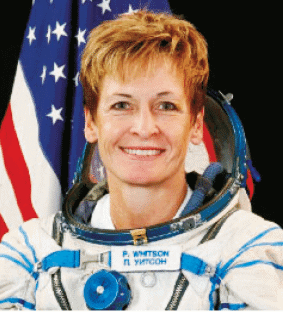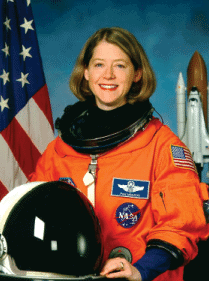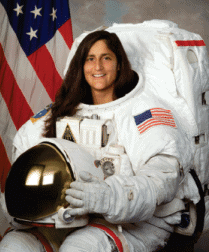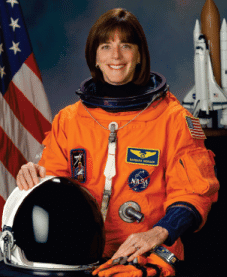Space Travel Chapter Notes | Communicative English for Class 10 PDF Download
| Table of contents |

|
| Key Points of the Story |

|
| Detailed Summary |

|
| Theme/ Message |

|
| Difficult Words |

|
Key Points of the Story
- Peggy Whitson has spent a total of 377 days in space, holding the record for the most time spent by any U.S. astronaut.
- She was the first woman to command the International Space Station (ISS) and completed two six-month missions.
- Whitson emphasizes the importance of fitness and adapting to zero gravity for astronauts.
- Pamela Melroy, another astronaut, successfully docked her spacecraft with the ISS, marking a historic moment for women in space.
- Melroy faced a crisis when a solar wing on the spacecraft was damaged, but her crew worked together to fix it.
- Sunita Williams broke the endurance record for the most time spent in space by a woman, spending 195 days in orbit.
- Williams enjoyed exercising in space and even ran an unofficial Boston Marathon on a treadmill while in orbit.
- Barbara Morgan, who waited 21 years for her chance to fly, taught lessons from space during her mission.
- Each astronaut shared their experiences and insights about what it is like to live and work in space.
- The astronauts discussed the importance of teamwork, courage, and the joy of exploring beyond Earth.
Detailed Summary
This chapter talks about four amazing women astronauts and their experiences in space. Each of them shares their stories about what it is like to live and work far away from Earth. Let’s look at each woman and what they did in space.
The first astronaut we meet is Peggy Whitson. She is 48 years old and has been an astronaut since 1996. Peggy spent a total of 377 days in space on two missions. She was the first woman to command the International Space Station (ISS). Imagine being in a small room with just a few people for six months! Peggy talks about how it felt like coming home when she went back to the ISS for her second time. She had learned how to live in space better and felt comfortable much faster. Being in space has some special effects, like making her look younger because there is no gravity pulling down on her.

Peggy describes the view of Earth from space as beautiful. When they fly around the planet every 90 minutes, they can see how thin the atmosphere is and all the different shades of blue. After returning to Earth, she found it hard to move quickly because her body had to get used to gravity again. But after some time, she was back to her normal self. Peggy believes that exploring space is very important for everyone and helps us learn more about ourselves and the universe.
Next, we meet Pamela Melroy, who is 47 years old and became an astronaut in 1995. She flew three shuttle missions. Pamela did something very tricky by flying the shuttle in a special backflip to check for any damage before docking with the space station. This moment was special because it was the first time two women were in charge of two spacecrafts at the same time! During one of her missions, a solar wing got damaged, and everyone was worried.

Pamela also talks about how things have changed for women in space. A long time ago, it would have been hard to imagine two women commanding spacecrafts at the same time. She and Peggy are good friends and enjoyed working together. Pamela misses the feeling of floating in zero gravity. She sometimes dreams about it, which makes her feel confused when she wakes up back on Earth. S
The third astronaut is Sunita Williams, who is 43 years old and became an astronaut in 1998. She spent 195 days in space and did many space walks. Sunita was excited to be in space for the first time for such a long time. She even ran the Boston Marathon on a treadmill while the space station orbited the Earth! That’s really impressive. Sunita explains how it was a little strange at first being in space with other astronauts, but she was well-prepared after a lot of training. She learned to move gracefully in zero gravity and preferred flying around instead of walking.

Sunita also had to exercise daily to keep her body strong. She found that having long hair in space was difficult because it floated everywhere, so she decided to cut it and donate her hair for a good cause.
Finally, we meet Barbara Morgan, who is 56 years old and has been an astronaut since 1985. Barbara waited a long time, 21 years, to go on her shuttle mission. She was chosen as a backup teacher for a special program but had to wait after a tragic accident. In 2007, she finally flew in space and was able to teach lessons about living in space. Barbara was surprised that her body felt strange when she first arrived in space, like it was upside down. But she also slept really well there, which was different from her life on Earth.

Food in space was another interesting topic for Barbara. She used meals as a way to teach students about science. Her favorite food was beef Stroganoff, and she enjoyed sharing meals with her crewmates.
In summary, this chapter tells us about the incredible journeys of four women who went to space. They each faced challenges but also experienced amazing things. Their stories show that women can do anything they set their minds to, even flying in space and commanding missions. They inspire us to dream big and explore the unknown!
Theme/ Message
- The main theme of the chapter is the pioneering spirit of women in space exploration.
- It highlights the challenges and triumphs faced by female astronauts, showcasing their contributions to science and exploration.
- The message emphasizes the importance of perseverance, teamwork, and the value of scientific exploration for humanity.
- It encourages readers to understand the significance of female role models in fields traditionally dominated by men.
- The astronauts inspire future generations to pursue their dreams, regardless of the obstacles they may face.
Difficult Words
- Astronaut: A person who travels into space.
- Mission: A specific task or journey, especially one undertaken for a purpose.
- Endurance: The ability to withstand difficult conditions over a long period.
- Gravity: The force that pulls objects toward the Earth.
- Docking: The process of bringing two spacecraft together in space.
- Solar wing: A part of a spacecraft that collects energy from the sun.
- Zero gravity: The state of having no weight or the feeling of floating.
- Fitness: The condition of being physically healthy and strong.
- Teamwork: Working together with others to achieve a common goal.
- Perseverance: Continuing to try despite difficulties.
- Tranquil: Calm and peaceful.
- Crisis: A time of intense difficulty or danger.
- Robotic: Related to machines that can perform tasks automatically.
- Exploration: The act of traveling to new places to learn about them.
- Veteran: A person who has had long experience in a particular field, especially in the military
|
8 videos|250 docs|8 tests
|
FAQs on Space Travel Chapter Notes - Communicative English for Class 10
| 1. What are the key points discussed in the chapter "Space Travel"? |  |
| 2. What is the detailed summary of the chapter "Space Travel"? |  |
| 3. What are the main themes or messages conveyed in "Space Travel"? |  |
| 4. What are some difficult words found in the chapter "Space Travel"? |  |
| 5. How does the chapter "Space Travel" relate to current advancements in space technology? |  |




















